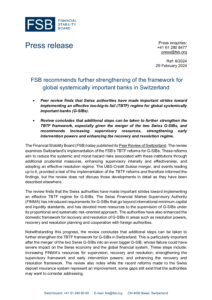This 2023 FSB Peer Review of Switzerland assesses Switzerland’s implementation of too-big-to-fail (TBTF) reforms for global systemically important banks (G-SIBs), focusing on reforms to enhance the intensity and effectiveness of supervisory oversight; prudential measures; and the resolution regime. The review was scoped prior to the UBS-Credit Suisse merger. The merger and events leading up to it provided a test of the implementation of the TBTF reforms and therefore informed the review, but the review does not discuss in detail those developments, which have been described elsewhere.
The review finds that, since the issuance by the FSB of the Key Attributes of Effective Resolution Regimes for Financial Institutions in 2011, the Swiss authorities have made important strides , toward implementing an effective TBTF regime for G-SIBs and have continued to enhance the country’s framework for recovery and resolution of G-SIBs.
The review includes recommendations to the Swiss authorities to further strengthen the TBTF framework for G-SIBs in Switzerland. These include: increasing the Swiss Financial Market Supervisory Authority’s (FINMA’s) resources for supervision, recovery and resolution; strengthening the supervisory framework and early intervention powers; and enhancing the recovery and resolution framework.
These steps are particularly important following the merger of the two Swiss G-SIBs into an even bigger G-SIB that will be the world’s largest as a percentage of home jurisdiction Gross Domestic Product (GDP) and whose failure could have severe impact on the Swiss economy and the global financial system.
Recommendations to further strengthen the TBTF framework for G-SIBs in Switzerland
Strengthening the supervisory framework and early intervention powers
Recommendation 1: FINMA’s resources should be increased to be able to effectively manage the supervision, recovery and resolution planning, and resolvability of the remaining G-SIB.
Recommendation 2: FINMA’s supervisory tools should be strengthened and widened by (i) introducing a Senior Managers regime in order to more easily take action against individual managers who fail their duties; (ii) obtaining the powers to publish its enforcement proceedings and (iii) implementing a structured and transparent early intervention framework that includes the ability to take into consideration qualitative and forward-looking metrics.
Recommendation 3: FINMA should revise its use of external audit firms for the supervision of banks, including by considering measures such as having FINMA directly contracting and paying for the audits, to address the governance and conflicts of interest issues.
Increasing the focus on recovery
Recommendation 4: The authorities should strengthen FINMA’s powers to assess the credibility and feasibility of recovery plans and to require a bank to take measures to address deficiencies in its recovery plan. FINMA should allocate more resources to recovery planning, especially for the remaining G-SIB, and establish a general policy or guidance on recovery planning.
Resolution planning
Recommendation 5: The authorities should strengthen the legal basis for FINMA, as part of resolution planning, to require identified G-SIBs to adopt changes to their business practices, structure or organisation to address a material impediment to resolvability.
Recommendation 6: FINMA should publish further information about the expectations on resolvability to which G-SIBs are held and enhance the readiness for resolution by (i) enhancing firm-level testing (ii) conducting domestic cross-authority exercises and (iii) assessing the adequacy of engaging with host authorities, including non-core CMG members, and the need for cross-border drills.
Entry into resolution
Recommendation 7: The authorities should consider whether the criteria in the Banking Act are sufficiently clear and flexible to enable FINMA to act when a firm is likely to be no longer viable. This should be supported by FINMA reviewing its internal point of non-viability (PONV) indicators and decision-making processes to ensure PONV assessments are sufficiently broad based and forward-looking.
Liquidity support for recovery and resolution
Recommendation 8: The authorities should take all steps needed to advance the legislation to make the public liquidity backstop mechanism a permanent feature of the Swiss resolution framework and to implement it on a timely basis once it is enacted.
Recommendation 9: The authorities should further strengthen contingent liquidity arrangements by ensuring that G-SIBs assess and prepare both on operational and legal fronts their ability to offer sufficient collateral to the SNB and other central banks. Contingent liquidity should be available in recovery (including the Early Intervention Framework) and resolution.
Recommendation 10: The authorities should further enhance their ability to assist the recovery of a distressed bank by minimising the risk of stigma from accessing central bank liquidity facilities. This would include considering the appropriateness of disclosures by the entity and the central bank in relation to banks’ use of emergency liquidity assistance where such disclosure is not in the public interest.
